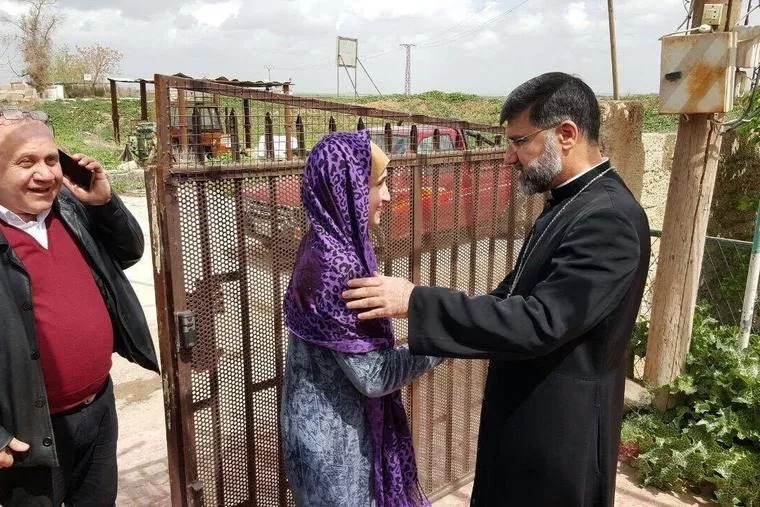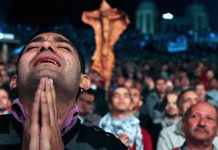Picture enclose/Last Assyrian Christian hostage released on March 27, 2016. (photo: Assyrian Church of the East Relief Organization / Facebook/Courtesy )
الخابور: تذكر أزمة الرهائن المسيحيين الآشوريين المخفية
ألبرتو م. فرنانديز/الكاثوليكية الوطنية/23 فبراير 2025
(ترجمة موقع غوغل)
Khabur: Recalling a Hidden Assyrian Christian Hostage Crisis
Alberto M. Fernandez/National Catholic/February 23, 2025
COMMENTARY: War-torn Syria was the site 10 years ago of one of the saddest and triumphant human rights crises in history.
They came before dawn, under the cover of darkness. Overpowering and killing three village guards, they took hundreds of captives — men, women and children, from the elderly to the very young. Then they looted homes and shops before reducing the village churches to rubble with high explosives.
This was the start of one of history’s saddest, strangest, least-known hostage crises, which began 10 years ago on Feb. 23, 2015. The setting was war-torn northeast Syria. Within the territory controlled by Kurdish fighters was a string of Assyrian Christian farming villages along the Khabur River. These Assyrians had arrived in French Mandate Syria as refugees in the 1930s. Before that, they had been driven from their Anatolian mountain homeland by the Ottoman Turks during the First World War, found temporary refuge in Iran, moved to Iraq, and then fled from massacres carried out by Iraqi nationalist troops.
These Christians were members of the Assyrian Church of the East, an ancient Church that flourished under the Persian Empire and has a rich spiritual and cultural history. The Assyrian Church has been in fruitful dialogue with the Catholic Church for decades and in 1994 signed a common Christological declaration. Members of the Assyrian Church can receive Holy Communion in the Chaldean Catholic Church (in communion with Rome) and vice versa, if no other options are available. Only last year, Pope Francis included the Assyrian mystic and theologian St. Isaac of Nineveh in the Roman Martyrology.
The Khabur raid on the Assyrians was carried out by the Islamic State, the Salafi-Jihadist terror group that had seized vast territories in Syria and Iraq. It was a time of extreme violence inflicted on the region’s Christians by the group.
Less than two weeks before the attack on the Assyrians, the Islamic State had staged the grotesque slaughter of 21 Christians — the Coptic Martyrs of Libya — on a beach at Sirte. Two months later, in April 2015, Islamic State propagandists released another horrific video, this one featuring the massacre of 30 Ethiopian Christians, also in Libya.
Johny Messo, president of the World Council of Arameans, recalled his reaction to those days in an interview with Aleteia:
“I remember receiving the call in the evening. A contact from the Khabur region, his voice trembling, told me that ISIS had just stormed the villages, taking women, children and the elderly hostage. He didn’t know where they were taken. Entire families had disappeared overnight while their homes and churches were reduced to rubble. The fear in his voice haunted me for days.”
The Assyrian hostages, 226 of them, were taken to ISIS-controlled territory nearby. They were harassed and repeatedly pressured to convert to Islam but were otherwise relatively unharmed. It seems that, possibly, one of them converted.
Contact was made through local Arab tribes. The terrorist group, which over the years had targeted and killed hundreds, if not thousands, of Christians, offered to release the hostages in exchange for ransom. Media reports cited demands of $50,000 per person or a total of $11 million. What actually transpired remains unknown and will likely never be fully revealed.
At the time, countries like France, Italy and Spain secured the release of hostages from terror groups, including ISIS, that had demanded ransom payments. All three countries denied that any payments were paid. The practice is illegal in many countries and remains a contentious issue among terrorism experts. Israel, in contrast, has negotiated hostage exchanges, at times releasing convicted terrorists and killers for its captives, including women and children.
Whatever the details, the effort to secure the release of Assyrian hostages was slow and arduous, led by the local Bishop Mar Afram Athneil. The Assyrian diaspora — a relatively small, poor Church of working-class parishioners scattered across the globe — mobilized to do what it could.
During the crisis, Australian-Assyrian academic Nicholas al-Jeloo gave a lecture at a local church, appealing for contributions. More than 500 people donated something that night. Two of the captives were his cousins. With such a small community of Assyrian Christians remaining, everyone knew someone connected in some way with the hostages — whether as relatives, friends or acquaintances of extended families.
On March 1, 2015, 19 hostages were released. On March 3, four more were freed, including a 6-year-old girl, Mariana Mirza. On May 26, two ladies in their 80s were also released. Then, on Aug. 12, 22 more hostages — 14 of them women — were set free.
Evidently dissatisfied with the pace of the exchanges, on Sept. 23, the terrorist group executed three hostages — Dr. Abdelmassih Enwiya, Assur Rustam Abraham and Bassam Issa Michael — and released a gruesome video of their murder on the Muslim Feast of the Sacrifice, Eid al-Adha. A month later, 37 hostages, most of them elderly, were freed. In December 2015, 50 more were released, including 25 on Christmas Day.
On Feb. 22, 2016, one year after the kidnapping, most of the remaining hostages were released. On March 28, 2016, the last captive, an Assyrian girl named Miriam David Talya, was freed. The group had set aside some young women to be forcibly married to ISIS fighters; one of them was taken away and never found but all the others were eventually released.
The price was steep — not so much in whatever may have exchanged hands, but in lives lost, the psychological trauma endured by the survivors, and the destruction of entire communities. At the start of the Syrian Civil War, the Khabur villages were home to 20,000 Assyrian Christians; today, only a few hundred remain. The villages are now either abandoned or occupied by Kurdish refugees displaced by fighting elsewhere in Syria.
Nearly all of these Assyrians have fled the country. Many have resettled in Australia, Germany or Sweden, while others have found refuge in Norway, Austria, Belgium, Russia, the United States, Canada and New Zealand.
A decade later, al-Jeloo asks, “What could I say about such a tragedy?”
Five hostages were lost — three of them murdered — but 221 were saved, plucked from the raging fire. It remains both a profound tragedy and an agonizing triumph.
**Alberto M. Fernandez Alberto M. Fernandez is a former U.S. diplomat and a contributor at EWTN News.
https://www.ncregister.com/commentaries/khabur-hidden-assyrian-christian-hostage-crisis-10-years
الخابور: تذكر أزمة الرهائن المسيحيين الآشوريين المخفية
ألبرتو م. فرنانديز/الكاثوليكية الوطنية/23 فبراير 2025
(ترجمة موقع غوغل)
التعليق: كانت سوريا التي مزقتها الحرب قبل 10 سنوات موقعًا لواحدة من أكثر أزمات حقوق الإنسان حزنًا وانتصارًا في التاريخ.
جاءوا قبل الفجر، تحت جنح الظلام. تغلبوا على ثلاثة حراس قرية وقتلوهم، وأسروا مئات الأسرى – رجال ونساء وأطفال، من كبار السن إلى صغار السن. ثم نهبوا المنازل والمتاجر قبل أن يحولوا كنائس القرية إلى أنقاض بالمتفجرات العالية.
كانت هذه بداية واحدة من أكثر أزمات الرهائن حزنًا وغرابة وأقلها شهرة في التاريخ، والتي بدأت قبل 10 سنوات في 23 فبراير 2015. كان المشهد شمال شرق سوريا الممزقة بالحرب. داخل الأراضي التي يسيطر عليها المقاتلون الأكراد كانت هناك سلسلة من القرى الزراعية المسيحية الآشورية على طول نهر الخابور. وصل هؤلاء الآشوريون إلى سوريا الانتدابية الفرنسية كلاجئين في ثلاثينيات القرن العشرين. وقبل ذلك، طردهم الأتراك العثمانيون من وطنهم الجبلي في الأناضول أثناء الحرب العالمية الأولى، ووجدوا ملجأ مؤقتًا في إيران، وانتقلوا إلى العراق، ثم فروا من المذابح التي نفذتها القوات القومية العراقية.
كان هؤلاء المسيحيون أعضاء في كنيسة المشرق الآشورية، وهي كنيسة قديمة ازدهرت في ظل الإمبراطورية الفارسية ولديها تاريخ روحي وثقافي غني. كانت الكنيسة الآشورية في حوار مثمر مع الكنيسة الكاثوليكية لعقود من الزمن وفي عام 1994 وقعت إعلانًا مسيحيًا مشتركًا. يمكن لأعضاء الكنيسة الآشورية تلقي القربان المقدس في الكنيسة الكلدانية الكاثوليكية (بالشراكة مع روما) والعكس صحيح، إذا لم تكن هناك خيارات أخرى متاحة. في العام الماضي فقط، أدرج البابا فرانسيس الصوفي واللاهوتي الآشوري القديس إسحق نينوى في سجل الاستشهاد الروماني.
كانت غارة الخابور على الآشوريين من تنفيذ تنظيم الدولة الإسلامية، الجماعة الإرهابية السلفية الجهادية التي استولت على أراضٍ شاسعة في سوريا والعراق. كانت فترة من العنف الشديد الذي مارسته الجماعة على المسيحيين في المنطقة.
قبل أقل من أسبوعين من الهجوم على الآشوريين، نفذ تنظيم الدولة الإسلامية مذبحة بشعة لـ 21 مسيحيًا – شهداء الأقباط في ليبيا – على شاطئ في سرت. بعد شهرين، في أبريل 2015، أصدر دعاة تنظيم الدولة الإسلامية مقطع فيديو مروعًا آخر، يظهر مذبحة 30 مسيحيًا إثيوبيًا، أيضًا في ليبيا.
يتذكر جوني ميسو، رئيس المجلس العالمي للآراميين، رد فعله على تلك الأيام في مقابلة مع أليتيا:
“أتذكر تلقي المكالمة في المساء. أخبرني أحد جهات الاتصال من منطقة الخابور، بصوت مرتجف، أن داعش اقتحمت للتو القرى، وأخذت النساء والأطفال وكبار السن رهائن. لم يكن يعرف إلى أين أخذوهم. “اختفت عائلات بأكملها بين عشية وضحاها بينما تحولت منازلها وكنائسها إلى أنقاض. كان الخوف في صوته يطاردني لأيام.”
تم نقل الرهائن الآشوريين، 226 منهم، إلى الأراضي التي تسيطر عليها داعش القريبة. تعرضوا للمضايقات والضغوط المتكررة للتحول إلى الإسلام ولكنهم لم يتعرضوا لأذى نسبيًا. يبدو أنه من المحتمل أن يكون أحدهم قد تحول.
تم الاتصال من خلال القبائل العربية المحلية. عرضت الجماعة الإرهابية، التي استهدفت وقتلت على مر السنين المئات، إن لم يكن الآلاف، من المسيحيين، إطلاق سراح الرهائن مقابل فدية. ذكرت التقارير الإعلامية مطالب بمبلغ 50 ألف دولار للشخص الواحد أو ما مجموعه 11 مليون دولار. ما حدث بالفعل لا يزال غير معروف ومن المرجح ألا يتم الكشف عنه بالكامل.
في ذلك الوقت، نجحت دول مثل فرنسا وإيطاليا وإسبانيا في تأمين إطلاق سراح رهائن من جماعات إرهابية، بما في ذلك داعش، التي طالبت بدفع فدية. ونفت الدول الثلاث دفع أي مبالغ. وتعتبر هذه الممارسة غير قانونية في العديد من البلدان وتظل قضية مثيرة للجدال بين خبراء الإرهاب. وعلى النقيض من ذلك، تفاوضت إسرائيل على تبادل الرهائن، وأطلقت في بعض الأحيان سراح إرهابيين مدانين وقاتلين مقابل أسراها، بما في ذلك النساء والأطفال.
وأياً كانت التفاصيل، فإن الجهود المبذولة لتأمين إطلاق سراح الرهائن الآشوريين كانت بطيئة وشاقة، بقيادة الأسقف المحلي مار أفرام أثنيل. وقد حشدت الجالية الآشورية في الشتات ــ وهي كنيسة صغيرة نسبيا فقيرة من أبناء الرعية من الطبقة العاملة المنتشرة في جميع أنحاء العالم ــ جهودها للقيام بما في وسعها.
خلال الأزمة، ألقى الأكاديمي الآشوري الأسترالي نيكولاس الجيلو محاضرة في كنيسة محلية، داعيا إلى التبرعات. وتبرع أكثر من 500 شخص بشيء في تلك الليلة. وكان اثنان من الأسرى أبناء عمه. ومع بقاء مثل هذا المجتمع الصغير من المسيحيين الآشوريين، كان الجميع يعرفون شخصًا مرتبطًا بطريقة ما بالرهائن – سواء كأقارب أو أصدقاء أو معارف لعائلات ممتدة.
في الأول من مارس 2015، تم إطلاق سراح 19 رهينة. وفي الثالث من مارس، تم إطلاق سراح أربعة آخرين، بما في ذلك فتاة تبلغ من العمر ست سنوات، ماريانا ميرزا. وفي 26 مايو، تم إطلاق سراح سيدتين في الثمانينيات من العمر أيضًا. ثم في 12 أغسطس، تم إطلاق سراح 22 رهينة آخرين – 14 منهم نساء.
ومن الواضح أن الجماعة الإرهابية غير راضية عن وتيرة التبادل، وفي 23 سبتمبر، أعدمت ثلاثة رهائن – الدكتور عبد المسيح عنوية، وآشور رستم إبراهيم وبسام عيسى ميخائيل – ونشرت مقطع فيديو مروعًا لقتلهم في عيد الأضحى. وبعد شهر، تم إطلاق سراح 37 رهينة، معظمهم من كبار السن. في ديسمبر/كانون الأول 2015، تم إطلاق سراح 50 آخرين، بما في ذلك 25 في يوم عيد الميلاد.
في 22 فبراير/شباط 2016، بعد مرور عام على الاختطاف، تم إطلاق سراح معظم الرهائن المتبقين. في 28 مارس/آذار 2016، تم إطلاق سراح آخر أسيرة، وهي فتاة آشورية تدعى ميريام ديفيد تاليا. كانت المجموعة قد خصصت بعض الشابات للزواج القسري من مقاتلي داعش؛ تم أخذ واحدة منهن ولم يتم العثور عليها أبدًا ولكن تم إطلاق سراح جميع الأخريات في النهاية.
كان الثمن باهظًا – ليس كثيرًا في ما قد يكون قد تم تبادله بين الأيدي، ولكن في الأرواح التي فقدت، والصدمة النفسية التي تحملها الناجون، وتدمير مجتمعات بأكملها. في بداية الحرب الأهلية السورية، كانت قرى الخابور موطنًا لـ 20 ألف مسيحي آشوري؛ اليوم، لم يبق سوى بضع مئات منهم. القرى الآن مهجورة أو محتلة من قبل اللاجئين الأكراد النازحين بسبب القتال في أماكن أخرى في سوريا.
لقد فر جميع هؤلاء الآشوريين تقريبًا من البلاد. لقد استقر العديد منهم في أستراليا أو ألمانيا أو السويد، بينما وجد آخرون ملجأ في النرويج والنمسا وبلجيكا وروسيا والولايات المتحدة وكندا ونيوزيلندا. بعد عقد من الزمان، يتساءل الجلو، “ماذا يمكنني أن أقول عن مثل هذه المأساة؟”
لقد فقدنا خمسة رهائن – ثلاثة منهم قُتلوا – ولكن تم إنقاذ 221، وتم انتشالهم من بين النيران المستعرة. ويظل الأمر مأساة عميقة وانتصارًا مؤلمًا.
**ألبرتو م. فرنانديز ألبيرتو م. فرنانديز دبلوماسي أمريكي سابق ومساهم في EWTN News.
https://www.ncregister.com/commentaries/khabur-hidden-assyrian-christian-hostage-crisis-10-years
fi dhalik alwaqti, najahat dual mithl faransa wa’iitalia wa’iisbania fi tamin ‘iitla






















